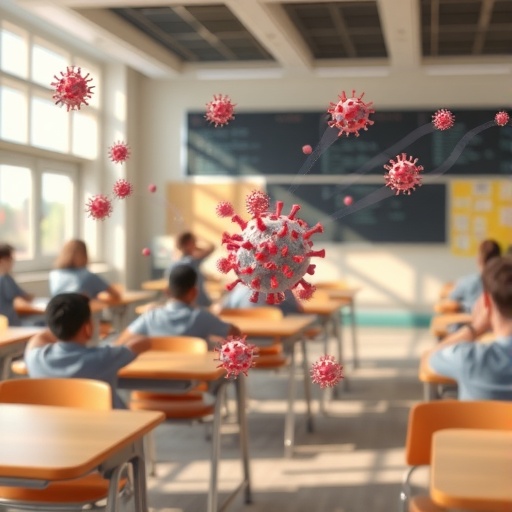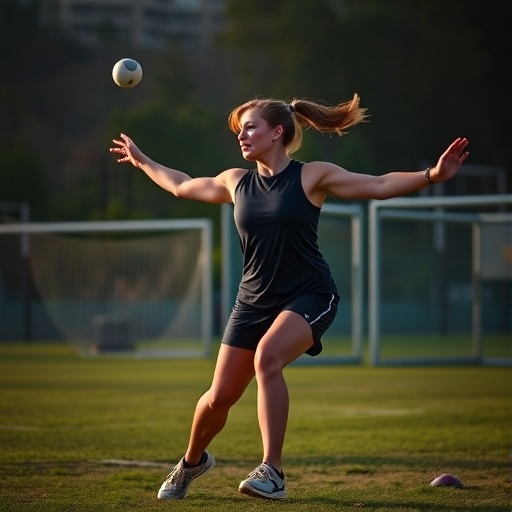A groundbreaking study published in Nature Communications in 2025 is reshaping our understanding of how respiratory viruses spread in school environments. The comprehensive research conducted by Banholzer, Munday, Jent, and colleagues meticulously disentangles the intricate web of transmission pathways, focusing on three pivotal factors: close-proximity contacts among students and staff, shared classroom exposure, and the critical role of indoor air quality. This multidisciplinary investigation provides a level of technical detail and clarity that could influence future public health policies and classroom ventilation standards worldwide.
The research zeroes in on the school environment, a setting often scrutinized for virus transmission yet notoriously complex to analyze due to the interplay of social behavior, architectural design, and ventilation systems. The novelty of this study lies in its ability to quantify, with remarkable precision, the relative contribution of each transmission vector, deploying state-of-the-art epidemiological modeling combined with empirical data gathered during active respiratory virus seasons.
Traditionally, public health interventions in schools have focused heavily on preventing close-proximity contact transmission. This includes measures such as social distancing, mask-wearing, and cohorting to restrict the number of intimate interactions. However, Banholzer et al. challenge this monolithic focus, revealing that while such interactions undeniably elevate transmission risk, they only tell part of the story. This nuance is crucial for policymakers aiming to design balanced, evidence-based strategies that do not overly disrupt essential educational and social functions.
Shared classroom exposure emerges as the second major vector examined. This refers to the scenario where students and teachers share the same indoor space for extended periods, regardless of whether they come into direct contact. The study leverages detailed occupancy and movement tracking data, linking it with infection rates to reveal that prolonged shared exposure contributes significantly to virus dissemination. This insight emphasizes the critical need for interventions that do not solely focus on interpersonal physical barriers but also consider environmental factors.
Arguably the most striking revelation is the role of indoor air quality in mediating viral spread within classrooms. Using advanced sensors and air sampling techniques, combined with computational fluid dynamics simulations, the researchers demonstrate that poor ventilation can exponentially increase infection risk by allowing infectious aerosols to accumulate. This elevates the importance of mechanical ventilation improvements, air filtration, and potentially the use of ultraviolet germicidal irradiation (UVGI) systems in mitigating the airborne route of transmission.
The methodology employed by Banholzer and colleagues integrates quantitative data streams including proximity sensor data, CO2 concentrations as a proxy for ventilation efficiency, and real-time viral load measurements in air samples. By layering these datasets, the study achieves an unparalleled resolution in pinpointing which transmission routes dominate in different scenarios. This multi-modal approach is a technical feat that sets a new standard for respiratory epidemiology in built environments.
Crucially, their findings indicate a synergistic effect between these factors rather than isolated impacts. For example, even with minimal close-proximity interactions, suboptimal ventilation can facilitate widespread airborne transmission within shared classrooms. Conversely, stringent airborne mitigation paired with attention to social contact patterns creates the most robust defense. This holistic perspective advocates for intersectional intervention policies that simultaneously address human behavior and environmental engineering.
The implications of this research extend beyond respiratory viruses like influenza or SARS-CoV-2 to other airborne pathogens that pose seasonal and endemic public health risks. The precision in identifying contributory factors allows school administrators to tailor approaches based on their specific infrastructure and population dynamics, enhancing both effectiveness and resource efficiency.
Moreover, the study challenges existing ventilation standards in educational institutions. Current guidelines often undervalue the direct impact of air exchange rates on infectious disease control. Banholzer et al. provide compelling evidence that upgrading ventilation systems is not just about comfort or carbon dioxide removal but is a critical line of defense against epidemic propagation.
On a technical front, the team’s use of high-resolution proximity sensors coupled with environmental monitoring showcases how integrating digital surveillance with classical epidemiology enhances predictive modeling. These technological advances empower rapid identification of super-spreader events, enabling timely interventions before outbreaks spiral.
Their data also reveal temporal fluctuations in transmission risk, linked to classroom occupancy patterns and ventilation cycles throughout the day. Insight into these dynamics permits the strategic scheduling of breaks and staggered attendance as additional tools to reduce viral load buildup indoors without severely compromising educational delivery.
The study’s strength lies in its large sample size, spanning multiple schools across diverse regions, ensuring the robustness and generalizability of its conclusions. This breadth bolsters the confidence that the relative contributions of transmission modes identified can inform global health guidelines tailored to diverse school settings.
Importantly, Banholzer et al. underscore that investing in indoor air quality improvements yields benefits far beyond controlling respiratory virus transmission. Enhanced ventilation also increases cognitive performance, reduces absenteeism, and contributes to overall wellbeing, underscoring a win-win scenario for policymakers and the communities they serve.
The researchers advocate for an integrated framework that includes continuous environmental monitoring paired with behavioral data collection to sustain safe in-person education during respiratory virus seasons. Such a system would provide dynamic risk assessments and allow schools to adjust protocols in real time, rather than rely on static, blanket policies that may be ineffective or overly restrictive.
This landmark study resonates today as schools worldwide grapple with balancing educational imperatives against viral transmission risks. Its technical depth, combined with actionable insights, charts a promising pathway toward safer school environments that retain social connectivity while mitigating disease spread.
In summary, Banholzer, Munday, Jent, and their team provide a compelling scientific narrative supported by rigorous data that elevates our understanding of respiratory virus transmission dynamics in schools. Their conclusions advocate for nuanced, multifaceted interventions focused equally on physical proximity, shared air exposure, and indoor air quality—an indispensable blueprint for the post-pandemic educational landscape.
Subject of Research: The relative contribution of close-proximity contacts, shared classroom exposure, and indoor air quality to respiratory virus transmission in schools.
Article Title: The relative contribution of close-proximity contacts, shared classroom exposure and indoor air quality to respiratory virus transmission in schools.
Article References: Banholzer, N., Munday, J.D., Jent, P. et al. The relative contribution of close-proximity contacts, shared classroom exposure and indoor air quality to respiratory virus transmission in schools. Nat Commun (2025). https://doi.org/10.1038/s41467-025-66719-3
Image Credits: AI Generated
Tags: architectural design and virus transmissionclassroom exposure to virusesclose-proximity contact among studentsepidemiological modeling of virus transmissionimpact of social behavior on virus spreadindoor air quality and respiratory virusesinnovative public health interventions for schoolsmultidisciplinary research on virus spreadpublic health policies for schoolsrespiratory virus seasons in schoolsschool virus transmission pathwaysventilation standards in educational settings





